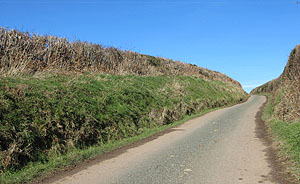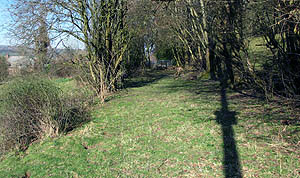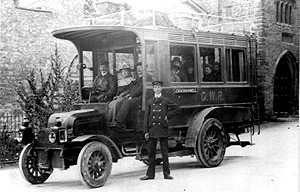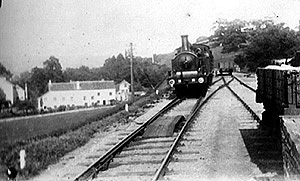Transport in the Glasbury area
The settlements in the Glasbury area developed by the river and
where there was easy access to crossings in the form of fords,
boats and ferries. Glasbury, Hay and the Boughrood area fulfilled
these criteria and rough roads/tracks would have been constructed
to connect them locally and also to connect them to the more major
settlements of Brecon to the west and Hereford to the east. In
time minor roads/tracks were created in the area and pushed out
on both sides of the river, these leading to homesteads and farms
well above the flood plain and catering for an expanding population.
Despite the Roman occupation of Brecon and Hereford and of some
evidential settlement at Aberllynfi, there is as yet no emergence
of any road linking them via the Glasbury area. Thus the first
indications of transport occur in the Medieval period in the form
of basic roads and tracks, some of these ever deepening as carts
and stock were moved up and down the steeper routes on both sides
of the valley, this finally ceasing with the advent of tarmacadam.
By the late 18th century the industrial revolution was well under
way and one effect of this was the necessity for the transport
of goods on a large scale. To this end a successful canal system
was emerging to carry supplies of raw materials such as coal ,
iron and limestone from the industrial centres of South Wales.
Prior to this the main method of transport was by packhorse or
oxen/horse-drawn carts along poorly maintained roads, many of
these being no more than deeply rutted and muddy tracks in bad
weather conditions.
Alongside this the mining of both stone and coal had resulted
in the introduction of basic railway systems, initially in the
mines, with the use of drams on rails that were pushed and pulled
by men and pit-ponies. The national railway system was a later
development and links were eventually built connecting this to
the mining industries and the canal systems.
There were now three competing modes of transport, with the canals
and railways initially being more efficient than the roads. This
was despite large investments for the introduction of newer roads
using turnpikes and tolls to pay for them.
At this time also the more affluent families had their own stables
and coaches for local travel such as shopping, going to church
and pertinent social commitments. Such was the case on the Maesllwch
and Gwernyfed Estates, Glasbury House and the Woodlands. Coaching
houses were becoming more utilised and both the Maesllwch Arms
and the Three Cocks hotel had stabling facilities along with food
and board.
It was the rise of the automobile at the start of the 19th century
that precipitated a marked improvement in the building of efficient
and lasting roads, aided by the use of finer roadstones, tarmacadam
and improved drainage. Road haulage and an expanding rail freight
system would eventually lead to the demise of the slower canals
at a commercial level.
The coming of more prosperity and a removal of petrol rationing
after the Second World War led to more road travel by individuals
and families. This coupled with the advent of the motorway system
and the Beeching report led to the demise of the Steam Rail era
and road became king for both leisure and commerce.
The motor-cycle also played its part during this time for the
less well off with many families owning a motor-cycle and sidecar,
complete with full camping equipment at holiday times. This fashion
has virtually ceased in modern times with most families owning
at least one car, although the motor-cycle on its own has survived
commercially and is used by young and old alike (often in clubs
and largish groups)
In response to the road transport competition British Rail began
investing in electrified and High Speed trains in the 1970's and
on major routes nationwide.
The rail system was finally privatised from 1994 to 1997, with
the Freight arm being sold outright and the rest of the system
split between more than 100 companies.
The rationalisation of these companies has led to a recent boom
in passenger numbers, albeit at inflated prices, and the current
trend for public and commercial transport is by both rail and
road.
After a long period of stagnation, significant sections of both
the rail and the canal systems are currently being used for leisure
activities and have enjoyed a renaissance throughout the UK. This
has largely been accomplished through voluntary expertise and
labour, coupled with private finance and public grants.
At an individual level the invention of the bicycle and its improving
design from the early to late 19th century provided a new means
of transport for work, leisure and sport ( cycle races ) and these
themes continue to the present day.
At this time there is only speculation as to whether the river
Wye up to Glasbury was ever utilised at a commercial level, although
as far back as 1662 an act had been obtained to make some parts
of the Wye navigable.
B Bowker
22.08.2013
Sources
: --
CPAT Archives - Historic Settlements Survey
- Transport and Communication
Radnorshire Society Transactions Vol 18 1948 - Railways and Radnorshire
by R. C. B. Oliver
British Rail archives



